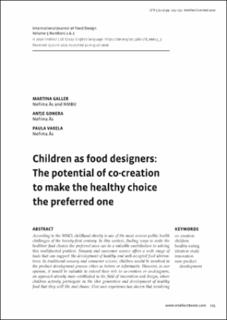| dc.contributor.author | Galler, Martina | |
| dc.contributor.author | Gonera, Antje | |
| dc.contributor.author | Varela, Paula | |
| dc.date.accessioned | 2021-01-27T11:06:25Z | |
| dc.date.available | 2021-01-27T11:06:25Z | |
| dc.date.created | 2021-01-11T12:01:30Z | |
| dc.date.issued | 2020 | |
| dc.identifier.citation | International Journal of Food Design. 2020, 5 (1-2), 125-131. | |
| dc.identifier.issn | 2056-6522 | |
| dc.identifier.uri | https://hdl.handle.net/11250/2724953 | |
| dc.description.abstract | According to the WHO, childhood obesity is one of the most serious public health challenges of the twenty-first century. In this context, finding ways to make the healthier food choices the preferred ones can be a valuable contribution to solving this multifaceted problem. Sensory and consumer science offers a wide range of tools that can support the development of healthy and well-accepted food alternatives. In traditional sensory and consumer science, children would be involved in the product development process either as testers or informants. However, in our opinion, it would be valuable to extend their role to co-creators or co-designers, an approach already more established in the field of innovation and design, where children actively participate in the idea generation and development of healthy food that they will like and choose. Our own experience has shown that involving children in the idea-generation step for healthy food can be highly motivating and stimulating for them. In this opinion article, we discuss why it is important to include children actively as a relevant consumer segment in product development and suggest a process and methods that could be valuable for brainstorming about food ideas with children. | |
| dc.language.iso | eng | |
| dc.subject | Innovasjon | |
| dc.subject | Innovation | |
| dc.subject | Ideation study | |
| dc.subject | Ideation study | |
| dc.subject | Barn | |
| dc.subject | Children | |
| dc.subject | Healthy eating | |
| dc.subject | Healthy eating | |
| dc.subject | Co creation | |
| dc.subject | Co creation | |
| dc.title | Children as food designers: The potential of co-creation to make the healthy choice the preferred one | |
| dc.type | Peer reviewed | |
| dc.type | Journal article | |
| dc.description.version | publishedVersion | |
| dc.source.pagenumber | 125-131 | |
| dc.source.volume | 5 | |
| dc.source.journal | International Journal of Food Design | |
| dc.source.issue | 1-2 | |
| dc.identifier.doi | https://doi.org/10.1386/ijfd_00015_3 | |
| dc.identifier.cristin | 1868836 | |
| dc.relation.project | Nofima AS: 201703 | |
| dc.relation.project | Nofima AS: 201702 | |
| dc.relation.project | Nofima AS: 12047 | |
| dc.relation.project | Norges forskningsråd: 262303 | |
| dc.relation.project | Norges forskningsråd: 262308 | |
| cristin.ispublished | true | |
| cristin.fulltext | original | |
| cristin.qualitycode | 1 | |
